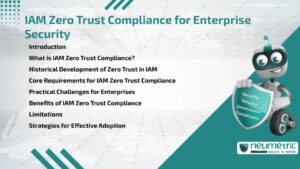Table of Contents
ToggleIntroduction
IAM Zero Trust Compliance has become a cornerstone of Enterprise Security in today’s Digital Landscape. Traditional Perimeter-based Models are no longer sufficient to address Insider Threats, Remote Work & Sophisticated Cyberattacks. Identity & Access Management [IAM] combined with Zero Trust Principles ensures that no User or device is trusted by default, even if inside the Network. Compliance with these practices strengthens Governance, reduces Risk & aligns Enterprises with Global Standards.
What is IAM Zero Trust Compliance?
IAM Zero Trust Compliance refers to aligning identity Governance with Zero Trust Frameworks & Regulatory requirements. It requires Continuous Verification of User Identities, strict Access Controls & Adaptive Security Policies. Instead of granting broad access, organisations validate every request based on Risk, Context & Least Privilege. Compliance demonstrates adherence to Standards such as ISO 27001, NIST Zero Trust Guidelines & GDPR.
Historical Development of Zero Trust in IAM
The Zero Trust Model was popularised in the early 2010s by Forrester Research as a response to growing Data Breaches. It challenged the traditional assumption that Threats only come from outside the Network. Over time, Regulators & CyberSecurity agencies like NIST formalised Zero Trust Architectures, embedding them into IAM Practices. Today, it is considered a best practice for Enterprises managing Hybrid & Cloud Environments.
Core Requirements for IAM Zero Trust Compliance
To achieve IAM Zero Trust Compliance, Enterprises must:
- Enforce strong Authentication, including Multi-factor methods
- Apply Least Privilege Access across all Accounts
- Continuously monitor User Sessions & Behaviour
- Segment Network to limit Lateral Movement
- Maintain Audit Trails for Compliance verification
- Automate provisioning & deprovisioning of User Accounts
Additional resources from ENISA provide implementation guidance.
Practical Challenges for Enterprises
Implementing IAM Zero Trust Compliance is not without obstacles. Legacy Systems may lack Compatibility with Zero Trust Frameworks. Deploying continuous Authentication can increase costs & require advanced Technology integration. Employees may resist stricter Access Controls if they perceive them as disruptive. Furthermore, global Enterprises must balance Zero Trust adoption with Compliance across multiple Regulatory regimes.
Benefits of IAM Zero Trust Compliance
The advantages are substantial:
- Reduced Risk of Insider Threats & Compromised Credentials
- Greater resilience against Ransomware & Phishing Attacks
- Easier Audit Readiness through Real-time Monitoring & Logging
- Improved Consumer & Partner Trust by demonstrating Advanced Security Practices
- Enhanced adaptability for Hybrid & Remote workforces
Limitations
Critics argue that full Zero Trust adoption can be expensive & complex, especially for smaller organisations. Some also note that overly strict controls may slow Business Operations. Additionally, Compliance with Zero Trust Principles does not guarantee immunity from all Threats but significantly lowers the Risk surface.
Strategies for Effective Adoption
Enterprises can succeed by:
- Starting with a phased rollout of Zero Trust Controls
- Conducting Risk Assessments to prioritise Critical Systems
- Training Employees to adapt to new IAM Processes
- Leveraging Automation for Continuous Verification
- Aligning Policies with Global Standards such as OECD Privacy guidelines & World Bank Governance resources
Takeaways
IAM Zero Trust Compliance is a strategic shift that redefines Enterprise Security. By enforcing Least Privilege, Continuous Authentication & Strong Governance, organisations can strengthen defences, reduce Risks & Align with Global Regulations.
FAQ
What is IAM Zero Trust Compliance?
It means aligning IAM Practices with Zero Trust Frameworks that require Continuous Verification & Least Privilege Access.
Why is Zero Trust important for Enterprises?
It reduces Risks from Insider Threats, Compromised Credentials & Advanced Cyberattacks.
What challenges do businesses face in adopting Zero Trust?
Challenges include Cost, System Compatibility, Employee resistance & Regulatory complexity.
Does Zero Trust guarantee full protection?
No, but it significantly reduces Risks by removing implicit trust & requiring ongoing verification.
Which standards guide Zero Trust adoption?
NIST Zero Trust Frameworks, ISO 27001, GDPR & ENISA guidelines are key references.
References
- ISO 27001 – Information Security
- NIST Zero Trust Guidelines
- ENISA – European Union Agency for CyberSecurity
- OECD Privacy Guidelines
- World Bank Digital Development
Need help for Security, Privacy, Governance & VAPT?
Neumetric provides organisations the necessary help to achieve their CyberSecurity, Compliance, Governance, Privacy, Certifications & Pentesting needs.
Organisations & Businesses, specifically those which provide SaaS & AI Solutions in the Fintech, BFSI & other regulated sectors, usually need a CyberSecurity Partner for meeting & maintaining the ongoing Security & Privacy needs & requirements of their Enterprise Clients & Privacy conscious Customers.
SOC 2, ISO 27001, ISO 42001, NIST, HIPAA, HECVAT, EU GDPR are some of the Frameworks that are served by Fusion – a SaaS, multimodular, multitenant, centralised, automated, CyberSecurity & Compliance Management system.
Neumetric also provides Expert Services for technical Security which covers VAPT for Web Applications, APIs, iOS & Android Mobile Apps, Security Testing for AWS & other Cloud Environments & Cloud Infrastructure & other similar scopes.
Reach out to us by Email or filling out the Contact Form…





